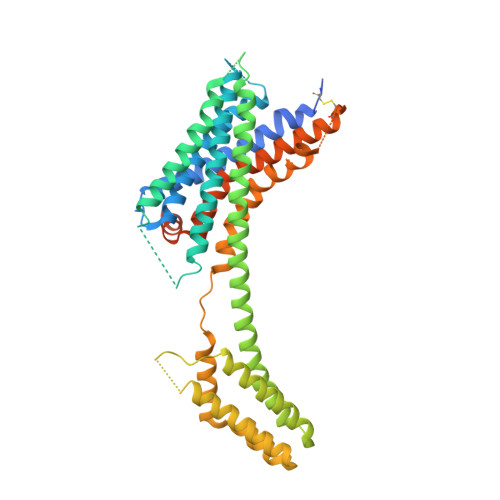Inverse agonist efficacy of selatogrel blunts constitutive P2Y12 receptor signaling by inducing the inactive receptor conformation.
Pons, V., Garcia, C., Tidten-Luksch, N., Mac Sweeney, A., Caroff, E., Gales, C., Riederer, M.A.(2022) Biochem Pharmacol 206: 115291-115291
- PubMed: 36306820
- DOI: https://doi.org/10.1016/j.bcp.2022.115291
- Primary Citation of Related Structures:
7PP1 - PubMed Abstract:
Selatogrel is a potent inhibitor of adenosine diphosphate (ADP) binding to the P2Y12 receptor, preventing platelet activation. We have previously shown that the P2Y12 receptor constitutively activates Gi- and Go-protein-mediated signaling in human platelets. Here, we report that selatogrel acts as an inverse agonist of the P2Y12 receptor. Specifically, using bioluminescence resonance energy transfer2 (BRET2) probes, selatogrel, ticagrelor, and elinogrel were shown to stabilize the inactive form of the G α i/o-G βγ complex in cells with recombinant expression of the P2Y12 receptor. In dose-response experiments, while selatogrel exhibited a maximal efficacy similar to ticagrelor, selatogrel was approximately 100-fold more potent than ticagrelor. Quantification of relative cyclic adenosine monophosphate (cAMP) levels in cells expressing the cAMP BRET1 sensor (CAMYEL probe) confirmed that selatogrel completely abolished the constitutive activity of the P2Y12 receptor. In agreement, selatogrel increased basal cAMP levels in human platelets, confirming inverse agonism on the endogenous human platelet P2Y12 receptor. In agreement with the biochemical phenotype of inverse agonism efficacy of selatogrel, the 2.8 Angstrom resolution cocrystal structure of selatogrel bound to the P2Y12 receptor confirmed that selatogrel stabilizes the inactive, basal state of the receptor. Selatogrel bound to pocket 1, spanning helix III to VII. Furthermore, the binding mode of selatogrel, suggesting steric overlap with the proposed binding site of ADP and the ADP analog 2-methylthioadenosine diphosphate (2MeSADP), agrees with the functional characterization of selatogrel preventing platelet activation by blocking ADP binding to the P2Y12 receptor.
- INSERM, UMR 1297, Institut des Maladies Métaboliques et Cardiovasculaires, Université de Toulouse, F-31432 Toulouse, France.
Organizational Affiliation:


















